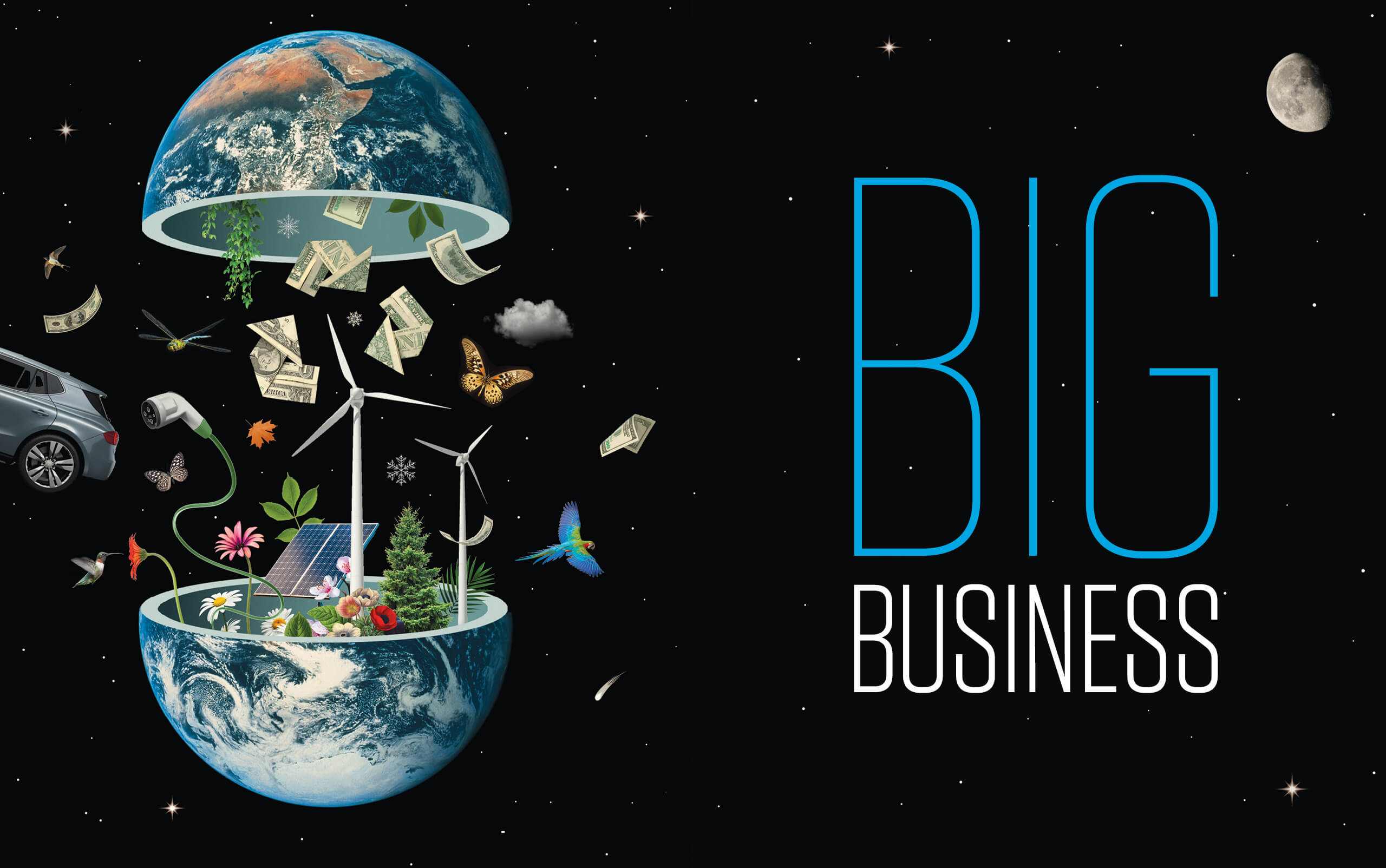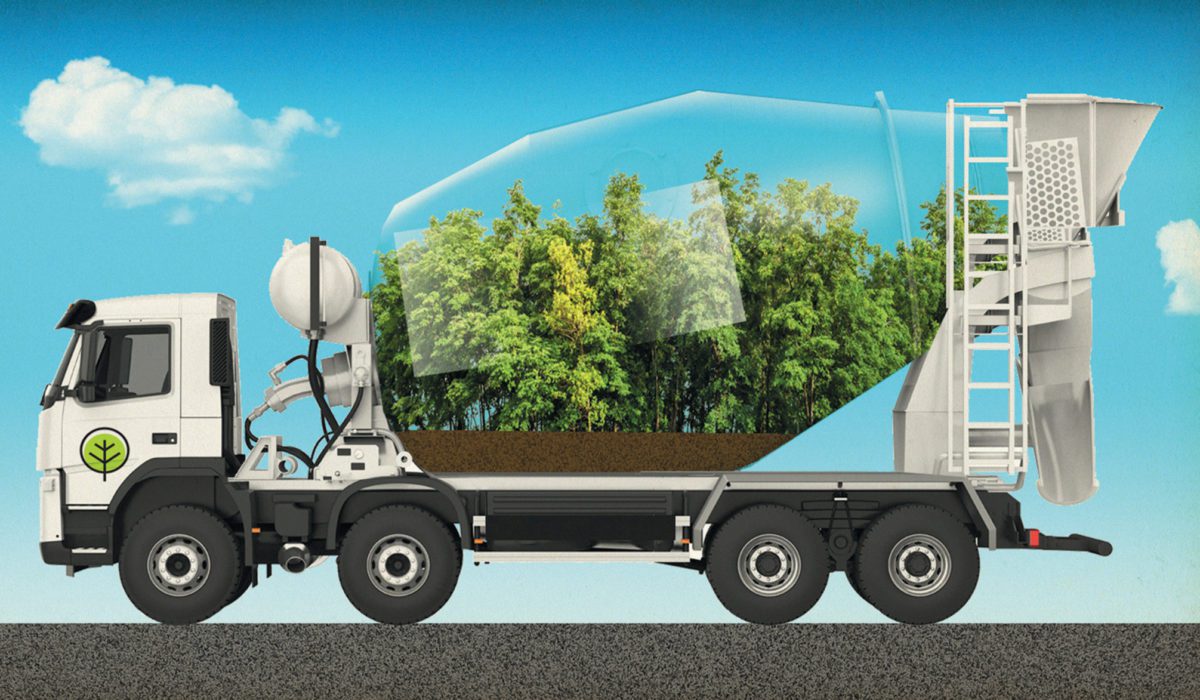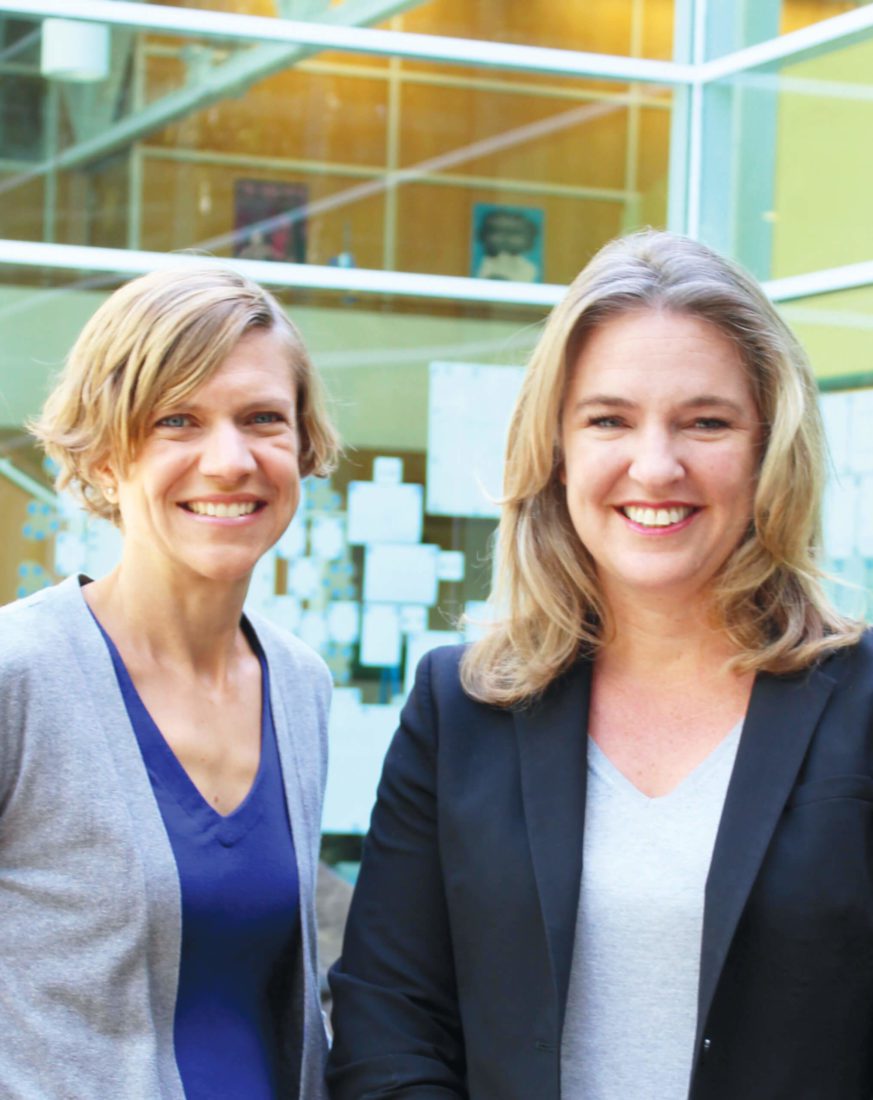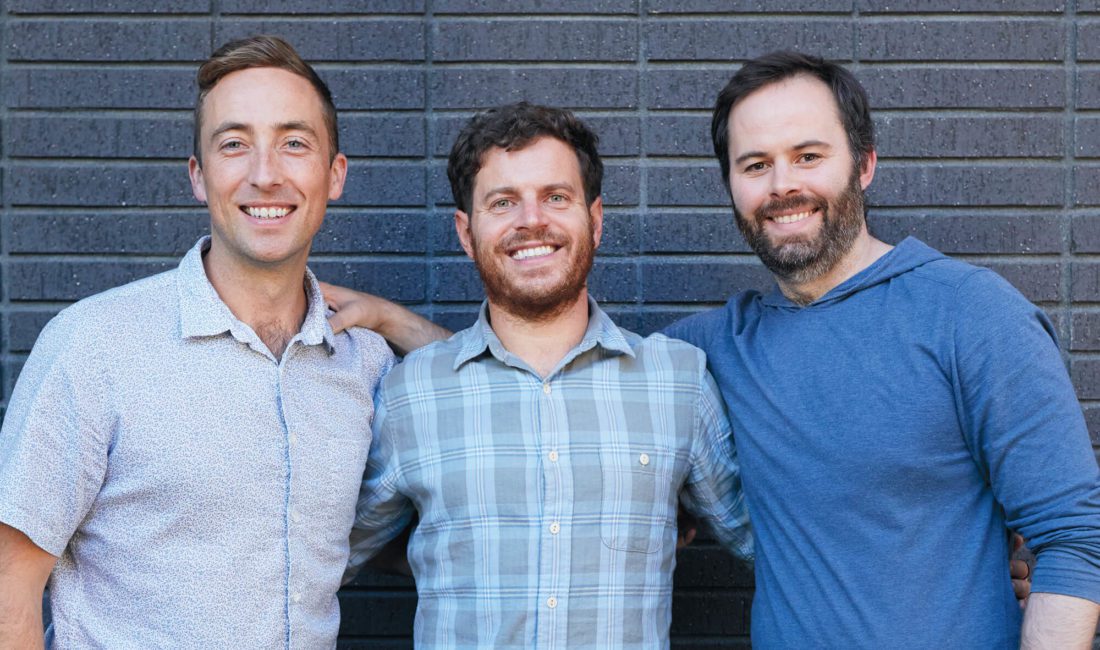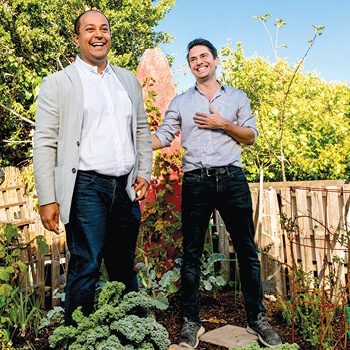Revolution Foods
Most people look at cement and see the humble ingredient that helps form concrete and therefore the bulk of our most crucial infrastructure. Few are aware that cement—like steel, aluminum, and other core building materials—is a top polluter, contributing up to 8% of global carbon emissions, according to think tank Chatham House. That’s more than three times the impact of aviation fuel.
 Kas Farsad, EMBA 18 (shown left), looks at cement and sees opportunity. Thirteen years ago, Farsad was one of the lead inventors on a team that discovered a method of making cement that mimics nature’s approach. While human-made cement is produced by burning materials that release carbon into the atmosphere, nature makes its cement (think rocks, shells, and reefs) by doing the reverse: pulling carbon from the air and reacting it with calcium. Farsad and his team proved successful in their gambit to do the same—and created a cement that reduces carbon emissions by 60% and uses almost half the natural resources to manufacture.
Kas Farsad, EMBA 18 (shown left), looks at cement and sees opportunity. Thirteen years ago, Farsad was one of the lead inventors on a team that discovered a method of making cement that mimics nature’s approach. While human-made cement is produced by burning materials that release carbon into the atmosphere, nature makes its cement (think rocks, shells, and reefs) by doing the reverse: pulling carbon from the air and reacting it with calcium. Farsad and his team proved successful in their gambit to do the same—and created a cement that reduces carbon emissions by 60% and uses almost half the natural resources to manufacture.
There was just one problem: It required new production plants and was therefore more expensive than traditional cement to produce. “It worked,” Farsad says. “But at that time, the economics were just not there. So we kind of fizzled.”
The story has a happy ending for both Farsad and the planet. Ten years after their discovery, the team figured out how to make their cement in traditional factories—and more cheaply than the regular stuff, no less. Their company, Fortera, has partnered with a major cement producer and plans to have their cement in production by the middle of 2022.
Farsad’s story exemplifies a tension familiar to many working to usher the world into a lower- carbon, more sustainable future: A better way of building, powering our lives, and doing business isn’t likely to catch on unless it also makes economic sense.
“The businesses that will be important in fighting climate change have to be financially sustainable too. If they aren’t, they won’t be around in five or 10 years.”
—Stuart Bernstein, BS 86
“For us to solve this climate problem, the solutions need to have good business fundamentals,” Farsad says.
In conversations with Farsad and many of his fellow alumni, this tension emerged time and again. These inventors, founders, business leaders, and investors who are scouting out a sustainable future and helping to define its shape are driven by both a desire to effect large-scale climate impact and a need to realize healthy profits. For them, profits are not incidental. Staying in the green financially represents another kind of sustainability—one that will help to ensure that their new products, business models, and visions of the future can persist.
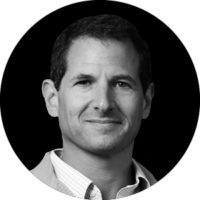 Stuart Bernstein, BS 86 (shown right), says that many people equate impact investing and sustainable industries solely with mission-driven endeavors.
Stuart Bernstein, BS 86 (shown right), says that many people equate impact investing and sustainable industries solely with mission-driven endeavors.
“Thinking of it that way is only half right,” says Bernstein, the founder and managing member of Sustainable Capital, an impact investment firm focused on companies applying emerging technologies to traditional industries in a sustainable way. “The businesses that will be important in fighting climate change have to be financially sustainable too. If they aren’t, they won’t be around in five or 10 years.”
Using a Sustainability Lens
Farsad and the others featured in this article chose Haas because its leaders and faculty understand the urgency and complexity of building profitable businesses that help the planet and its people. And within Haas, the sustainability focus is only getting stronger.
Already, Haas boasts a highly respected Energy Institute as well as the Sustainable and Impact Finance Initiative, the Center for Responsible Business, the Sustainable Food Initiative, and the Fisher Center for Real Estate and Urban Economics, which is pivoting to focus on sustainability in the built environment and the financing that fuels it.
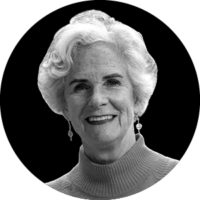 Michele de Nevers (shown left), executive director of sustainability programs at Haas, says the goal is to establish Haas as the top business school on sustainability. She and her team are working with faculty to integrate relevant sustainability topics into all core MBA courses.
Michele de Nevers (shown left), executive director of sustainability programs at Haas, says the goal is to establish Haas as the top business school on sustainability. She and her team are working with faculty to integrate relevant sustainability topics into all core MBA courses.
“We want every Haas graduate to have an understanding of the key issues, challenges, and framing of sustainability,” de Nevers says.
More options for students who want sustainability central to their studies have been recently unveiled or are coming soon. For example, students now have the option of earning the Michaels’ Graduate Certificate in Sustainable Business, which launched last January thanks to a $1 million gift from Doris and Charlie Michaels, BS 78.
 “There’s a revolution underway,” says Michaels (shown right), the co-founder and CEO of Sierra Global Management. “The transition from a carbon-producing economy to a carbon-free economy is one of the biggest economic changes in history. It touches everything.”
“There’s a revolution underway,” says Michaels (shown right), the co-founder and CEO of Sierra Global Management. “The transition from a carbon-producing economy to a carbon-free economy is one of the biggest economic changes in history. It touches everything.”
Indeed, many parts of the economy are now signaling a sudden eagerness to transition to a lower-carbon future. Global investors closed as many climate-themed funds in the first half of 2021 as they had during the previous five years combined, PitchBook reports. In those six months, venture-backed climate tech companies raised more than $14.2 billion—almost 90% of the 2020 total.
“It’s the first time we’ve ever had significant dollars flowing into climate technology,” says Mira Inbar, MBA 09 (shown below), a partner at ArcTern Ventures, which invests in early stage companies that are part of the green-energy transition. “There’s always been a real scarcity of funding.”
“The transition from a carbon-producing economy to a carbon-free economy is one of the biggest economic changes in history. It touches everything.”
—Charlie Michaels, BS 78
Still, she says, these investment totals need to grow significantly to have real environmental impact.
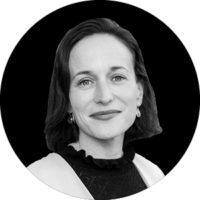 Inbar came to venture investing after spending over a decade working in energy-intensive industries like oil and gas, creating clean energy businesses from within. At Dow Chemical, she built a lithium ion battery business for electric transportation. At NRG Energy, she focused on renewables development, and at Shell she helped build a residential power business for North America. Ultimately, Inbar came to believe that, even though these large legacy businesses need to transition to low-carbon business models, the major disruptions that the climate and economy urgently need wouldn’t likely come from within these industries but from upstarts outside them.
Inbar came to venture investing after spending over a decade working in energy-intensive industries like oil and gas, creating clean energy businesses from within. At Dow Chemical, she built a lithium ion battery business for electric transportation. At NRG Energy, she focused on renewables development, and at Shell she helped build a residential power business for North America. Ultimately, Inbar came to believe that, even though these large legacy businesses need to transition to low-carbon business models, the major disruptions that the climate and economy urgently need wouldn’t likely come from within these industries but from upstarts outside them.
“I wanted to take the knowledge and experience I had,” Inbar says, “and help early companies that are part of the next wave of the economy—which will be a greener, lower-carbon economy—to grow and scale and be more impactful.”
Connecting with Capital
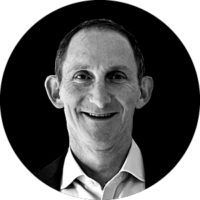 Though some governments are taking initial steps to funnel resources into climate change mitigation and adaptation measures—like the European Green Deal—the private sector’s investment in climate solutions will be just as crucial, says Tony Lent, MBA 90 (shown right).
Though some governments are taking initial steps to funnel resources into climate change mitigation and adaptation measures—like the European Green Deal—the private sector’s investment in climate solutions will be just as crucial, says Tony Lent, MBA 90 (shown right).
He points to the whopping $130 trillion in assets under management controlled by asset owners, investment managers, and banks who have pledged to help the economy achieve net-zero emissions by 2050 as part of the Glasgow Financial Alliance for Net Zero (GFANZ), which launched in April.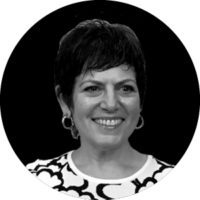
With this mobilization and others like it, he believes, comes a pressing need: Investors now must be able to understand decarbonization opportunity beyond renewables and act on it. Research indicates that large-scale wind and solar installations will be responsible for roughly 35% of required emissions reductions by 2050, he explains. Yet, they currently receive a disproportionate 80% of climate-focused investment. Climate opportunities in agriculture, industrial emissions, natural capital, and negative-emissions technology are equally important and significantly underinvested, Lent says.
To help ameliorate this mismatch, Lent and Deborah Stern, MBA 84 (shown above left), joined forces to create Capital for Climate, an investment platform to provide guidance on the landscape of climate solution opportunity that is aligned with leading science-based decarbonization roadmaps to achieve net zero. It’s designed to make it easier for large-scale investors, like pension funds, asset managers, and family offices, to identify and evaluate fund managers that focus on these climate solutions investments. Capital for Climate aims to help move billions of dollars a year into underfunded climate projects and technologies.
Rethinking Supply Chains
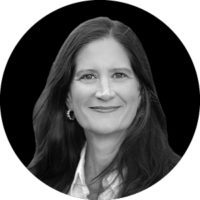 Education is also fundamental to the work that Shannon Graham, MBA 03 (shown right), does as a director and team lead focused on large European and Middle Eastern corporates at management consulting firm Guidehouse. She assists all levels of teams within companies along their sustainability journeys.
Education is also fundamental to the work that Shannon Graham, MBA 03 (shown right), does as a director and team lead focused on large European and Middle Eastern corporates at management consulting firm Guidehouse. She assists all levels of teams within companies along their sustainability journeys.
“I went to Haas because I wanted to be someone who could be a bridge across different disciplines, bring in information, and make things happen,” Graham says. “I wanted to see change.”
Prior to her role with Guidehouse, Graham had been a director in the energy practice at consulting firm Navigant (acquired by Guidehouse in 2019). One of her projects was helping a global logistics company headquartered in Dubai to decarbonize. Not only did the project draw on Graham’s technical background in renewable energy and energy efficiency, but it required her to deeply consider what drives behavioral change among busy management teams.
“How do you make it worthwhile for someone to put sustainability on the agenda?” she says. “You have to change the key performance indicators for leaders across a company, and the CEO needs to emphasize the importance while driving accountability.”
 Susy Schöneberg, MBA 17 (shown left), also aims to significantly disrupt business as usual.
Susy Schöneberg, MBA 17 (shown left), also aims to significantly disrupt business as usual.
“If you want to change a whole industry, the business model is really important,” she says—especially in logistics and transportation. Transportation is one of the few sectors where emissions are on the rise and projected to increase. Schöneberg figured that supply chains also stood to play a critical role in addressing social issues.
Research indicates that large-scale wind and solar installations will be responsible for roughly 35% of required emissions reductions by 2050. Yet, they currently receive a disproportionate 80% of climate-focused investment.
She’s now at Flexport, a technology company making global trade easy and accessible for everyone. She founded and leads Flexport.org, which serves two networks: first, the thousands of companies working toward carbon neutrality in their supply chains. The Flexport platform calculates a company’s carbon emissions and finds turnkey ways to reduce and offset shipping impact. Second, the nonprofits, aid agencies, and social enterprises distributing goods to people in need. Flexport.org offers logistics services to these organizations (often supported by the Flexport. org Fund), whether they’re moving supplies to Afghan refugees, food to survivors of a natural disaster, or COVID-19 protective equipment.
In 2020, Flexport.org fully funded COVID-related aid shipments that reached over 100 million people—just the kind of impact Schöneberg had been seeking.
Making Electricity Work
Solar energy is one area where the economic incentives are finally in the right place—what remains is the need to dramatically increase market adoption.
“Today’s solar costs are so low that it’s the most economical form of kilowatt hour you can deliver to a load,” says Raghu Belur, MBA 09 (shown right), founder and chief products officer at Enphase Energy, which makes smart home-energy systems including components like solar microinverters that are used in 1.5 million homes worldwide.
And yet, Belur points out, solar penetration in the U.S. is only about 3%.

He hopes that Enphase—founded in 2006 and today an S&P 500 company valued at over $20 billion—can play a key role in helping change that with its transformative approach to solar energy. The Enphase Energy system pulls together solar generation, home batteries, and an app, which together allow users to make, use, save, and sell their own power.
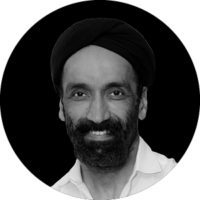 Powering electric vehicles is another area with sky-high potential for growth—and major implications for the planet. While EVs today only account for about 4% of the world’s cars, major car manufacturers are announcing ambitious goals to transition fully to electric fleets in the coming decades.
Powering electric vehicles is another area with sky-high potential for growth—and major implications for the planet. While EVs today only account for about 4% of the world’s cars, major car manufacturers are announcing ambitious goals to transition fully to electric fleets in the coming decades.
Jagdeep Singh, MBA 90 (shown left), founded and leads QuantumScape to help carmakers get there. The company is developing solid-state batteries for EVs with 50–80% more energy density than today’s best cells, which will mean more range per charge and faster charging.
“Circularity is a different lens through which to look at sustainability. It really focuses on waste and inefficiency across the entire value chain.”
—Evan Wiener, MBA 14
As a startup, QuantumScape received investment capital from Bill Gates and Volkswagen, which also took an ownership stake in the company and is partnering on a manufacturing joint venture.
“You can’t mandate your way to getting people to drive cleaner cars,” Singh says. “You have to have products people want to buy.”
In other words, he says, EVs must run on batteries that better compete with combustion engines. Singh believes that QuantumScape batteries, which he projects will be in commercial production by 2025, can help narrow that gap.
Embracing Circularity
 As companies’ efforts to boost their sustainability practices improve, many of them will confront difficult tradeoffs—something Evan Wiener, MBA 14 (shown right), grappled with as global director of sustainability and circularity services at Nike.
As companies’ efforts to boost their sustainability practices improve, many of them will confront difficult tradeoffs—something Evan Wiener, MBA 14 (shown right), grappled with as global director of sustainability and circularity services at Nike.
Wiener and his team were tasked with designing, testing, and scaling services to promote circularity by helping consumers extend the life of their athletic gear or to responsibly recycle or donate it when worn out.
“Circularity is a different lens through which to look at sustainability,” says Wiener, who recently became the general manager of circular business at clothing retailer H&M. “It really focuses on waste and inefficiency across the entire value chain.”
“It’s the first time we’ve ever had significant dollars flowing into climate technology. There’s always been a real scarcity of funding.”
—Mira Inbar, MBA 09
The complication is that in some cases, these programs can actually increase a product’s carbon footprint. Even as companies grapple with these types of tradeoffs, Wiener emphasizes that moving toward more circular business models is critical, because it helps companies conceive of value streams in new, less linear ways—which encourages them to innovate new services, processes, manufacturing methods, and products. Like, for example, selling secondhand goods.
“Lots of people can make money,” Wiener says. “What’s really hard is to make money and do it in a way that is truly sustainable—environmentally, socially, and economically.”
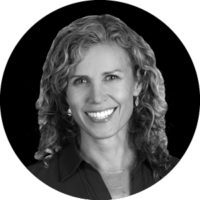 Lynelle Cameron, MBA 01 (shown left), took on her current role as vice president of sustainability at software company Autodesk because she believes that circularity and sustainability must be embedded into every aspect of business and design—and that businesses achieving this will gain a competitive edge.
Lynelle Cameron, MBA 01 (shown left), took on her current role as vice president of sustainability at software company Autodesk because she believes that circularity and sustainability must be embedded into every aspect of business and design—and that businesses achieving this will gain a competitive edge.
“I kept hearing about this software company that makes the technology that’s used to design and make quite literally anything on the planet— hardware, buildings, infrastructure, utility grids, even media and entertainment,” says Cameron, who was leading a sustainability team at Hewlett Packard at the time. That company was Autodesk, and its reach (and therefore impact) thrilled her. “I thought, ‘What if we could embed sustainability into this software to make it easy for any designer to make better choices?’”
She wrote Autodesk a letter that laid out her vision and was hired to start a sustainability program there. During her tenure, she also founded and serves as CEO of the Autodesk Foundation, which invests in entrepreneurs who are accelerating the transition to a sustainable and resilient economy.
Cameron’s reasoning in pursuing a 20-year career in sustainability is consistent with what has guided so many of her fellow alumni on their own career trajectories: “I wanted to use my business degree to help move toward a better future for all,” she says.
Posted in:
Topics:
